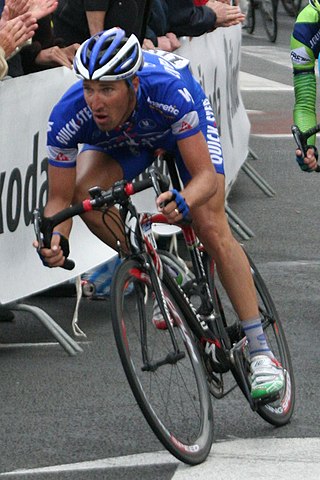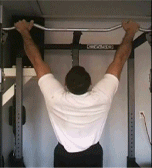Related Research Articles

Calisthenics or callisthenics (/ˌkælɪsˈθɛnɪk/) is a form of strength training that utilizes an individual's body weight as resistance to perform multi-joint, compound movements with little or no equipment.

Aerobic exercise is physical exercise of low to high intensity that depends primarily on the aerobic energy-generating process. "Aerobic" is defined as "relating to, involving, or requiring oxygen", and refers to the use of oxygen to meet energy demands during exercise via aerobic metabolism adequately. Aerobic exercise is performed by repeating sequences of light-to-moderate intensity activities for extended periods of time. Examples of cardiovascular or aerobic exercise are medium- to long-distance running or jogging, swimming, cycling, stair climbing and walking.

Physical fitness is a state of health and well-being and, more specifically, the ability to perform aspects of sports, occupations, and daily activities. Physical fitness is generally achieved through proper nutrition, moderate-vigorous physical exercise, and sufficient rest along with a formal recovery plan.

Anaerobic exercise is a type of exercise that breaks down glucose in the body without using oxygen; anaerobic means "without oxygen". In practical terms, this means that anaerobic exercise is more intense, but shorter in duration than aerobic exercise.
V̇O2 max (also maximal oxygen consumption, maximal oxygen uptake or maximal aerobic capacity) is the maximum rate of oxygen consumption attainable during physical exertion. The name is derived from three abbreviations: "V̇" for volume (the dot over the V indicates "per unit of time" in Newton's notation), "O2" for oxygen, and "max" for maximum and usually normalized per kilogram of body mass. A similar measure is V̇O2 peak (peak oxygen consumption), which is the measurable value from a session of physical exercise, be it incremental or otherwise. It could match or underestimate the actual V̇O2 max. Confusion between the values in older and popular fitness literature is common. The capacity of the lung to exchange oxygen and carbon dioxide is constrained by the rate of blood oxygen transport to active tissue.

Exercise intensity refers to how much energy is expended when exercising. Perceived intensity varies with each person. It has been found that intensity has an effect on what fuel the body uses and what kind of adaptations the body makes after exercise. Intensity is the amount of physical power that the body uses when performing an activity. For example, exercise intensity defines how hard the body has to work to walk a mile in 20 minutes.

Strength training, also known as weight training or resistance training, involves the performance of physical exercises that are designed to improve strength and endurance. It is often associated with the lifting of weights. It can also incorporate a variety of training techniques such as bodyweight exercises, isometrics, and plyometrics.

High-intensity interval training (HIIT) is a training protocol alternating short periods of intense or explosive anaerobic exercise with brief recovery periods until the point of exhaustion. HIIT involves exercises performed in repeated quick bursts at maximum or near maximal effort with periods of rest or low activity between bouts. The very high level of intensity, the interval duration, and number of bouts distinguish it from aerobic (cardiovascular) activity, because the body significantly recruits anaerobic energy systems. The method thereby relies on "the anaerobic energy releasing system almost maximally".

Plyometrics, also known as jump training or plyos, are exercises in which muscles exert maximum force in short intervals of time, with the goal of increasing power (speed-strength). This training focuses on learning to move from a muscle extension to a contraction in a rapid or "explosive" manner, such as in specialized repeated jumping. Plyometrics are primarily used by athletes, especially martial artists, sprinters and high jumpers, to improve performance, and are used in the fitness field to a much lesser degree.
Interval training is a type of training exercise that involves a series of high-intensity workouts interspersed with rest or break periods. The high-intensity periods are typically at or close to anaerobic exercise, while the recovery periods involve activity of lower intensity. Varying the intensity of effort exercises the heart muscle, providing a cardiovascular workout, improving aerobic capacity and permitting the person to exercise for longer and/or at more intense levels.
PHA training or peripheral heart action training is a form of bodybuilding circuit training that was popularized by former AAU Mr. America and Mr. Universe Bob Gajda in the 1960s. The smaller muscles around the heart are worked on first before the larger muscles around the body's periphery.
Abdominal exercises are a type of strength exercise that affect the abdominal muscles. Human abdominal consist of four muscles which are the rectus abdomens, internal oblique, external oblique, and transversus abdominis. When performing abdominal exercises it is important to understand the effects, functions, the types of exercises, and think about how to perform this exercise safely.

Endurance training is the act of exercising to increase endurance. The term endurance training generally refers to training the aerobic system as opposed to the anaerobic system. The need for endurance in sports is often predicated as the need of cardiovascular and simple muscular endurance, but the issue of endurance is far more complex. Endurance can be divided into two categories including: general endurance and specific endurance. Endurance in sport is closely tied to the execution of skill and technique. A well conditioned athlete can be defined as, the athlete who executes his or her technique consistently and effectively with the least effort. Key for measuring endurance are heart rate, power in cycling and pace in running.

The following outline is provided as an overview of and topical guide to exercise:

Spot reduction refers to the claim that fat in a certain area of the body can be targeted for reduction through exercise of specific muscles in that desired area. For example, exercising the abdominal muscles in an effort to lose weight in or around one's midsection. Fitness coaches and medical professionals as well as physiologists consider the claim to be disproved.

Bodyweight exercises are strength training exercises that use an individual's own weight to provide resistance against gravity. Bodyweight exercises can enhance a range of biomotor abilities including strength, power, endurance, speed, flexibility, coordination and balance. Such strength training has become more popular among recreational and professional athletes. Bodyweight training uses simple abilities like pushing, pulling, squatting, bending, twisting and balancing. Movements such as the push-up, the pull-up, and the sit-up are among the most common bodyweight exercises.

The Bulgarian bag, also known as the Bulgarian training bag, is a crescent-shaped piece of exercise equipment used in strength training, plyometric weight training, cardiovascular training, and general physical fitness. The bags are made of leather or canvas and filled with sand; they weigh from 11 pounds (5.0 kg) to 50 pounds (23 kg) and have flexible handles to allow for both upper and lower body training, and for building grip strength.

Cardiovascular fitness refers to a health-related component of physical fitness that is brought about by sustained physical activity. A person's ability to deliver oxygen to the working muscles is affected by many physiological parameters, including heart rate, stroke volume, cardiac output, and maximal oxygen consumption.

Power training typically involves exercises which apply the maximum amount of force as fast as possible; on the basis that strength + speed = power. Jumping with weights or throwing weights are two examples of power training exercises. Regular weight training exercises such as the clean and jerk and power clean may also be considered as being power training exercises due to the explosive speed required to complete the lifts. Power training may also involve contrasting exercises such as heavy lifts and plyometrics, known as complex training, in an attempt to combine the maximal lifting exertions with dynamic movements. This combination of a high strength exercise with a high speed exercise may lead to an increased ability to apply power. Power training frequently specifically utilises two physiological processes which increase in conjunction with one another during exercise. These are deep breathing, which results in increased intra-abdominal pressure; and post-activation potentation, which is the enhanced activation of the nervous system and increased muscle fibre recruitment. Power training programmes may be shaped to increase the trainee's ability to apply power in general, to meet sports specific criteria, or both.
The benefits of physical activity range widely. Most types of physical activity improve health and well-being.
References
- ↑ Comyns, Tom. "CIRCUIT TRAINING. Development of Strength & Conditioning" (PDF). Coaching Ireland. Retrieved 19 July 2018.
- 1 2 Kraviz, Len (1996-01-01). "New Insights into Circuit Training". University of New Mexico. Retrieved 2006-11-16.
- ↑ Brian Mackenzie. "Circuit Training". brianmac.co.uk.
- ↑ Heavin, Gary and Colman, Carol, C. Reprint edition (December 7, 2004). Curves: Permanent Results Without Permanent Dieting, ISBN 0-399-52956-X
- ↑ Klika, Brett; et al. "High-Intensity Circuit Training Using Body Weight: Maximum Results With Minimal Investment". ACSM's Health & Fitness Journal. doi: 10.1249/FIT.0b013e31828cb1e8 . S2CID 123383179 . Retrieved 20 September 2013.
{{cite journal}}: Cite journal requires|journal=(help) - ↑ "Kinesiology | West Valley College" (PDF).
- Kravitz, L. (1996). "The fitness professional's complete guide to circuits and intervals". IDEA Today, 14(1), 32–43.
- "American College of Sports Medicine Position Stand. The recommended quantity and quality of exercise for developing and maintaining cardiorespiratory and muscular fitness, and flexibility in healthy adults". Medicine & Science in Sports & Exercise. 30 (6): 975–991. 1998. doi: 10.1097/00005768-199806000-00032 . PMID 9624661.